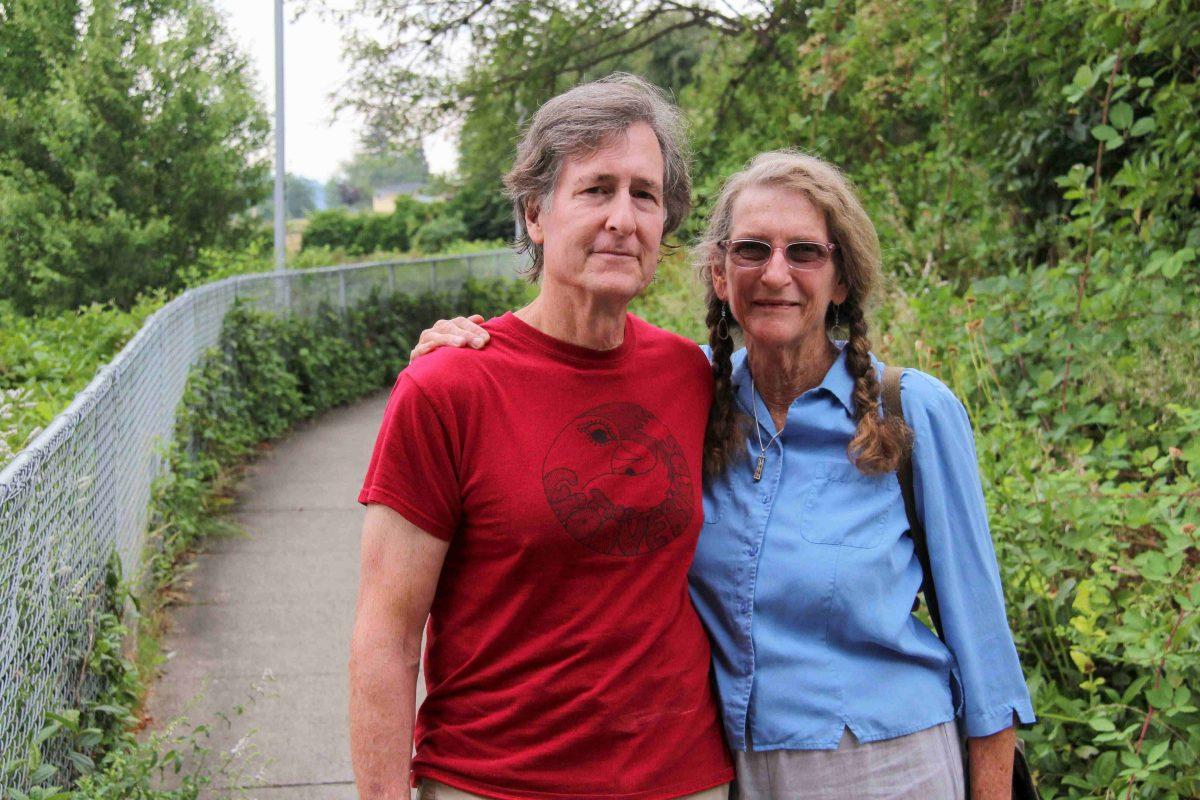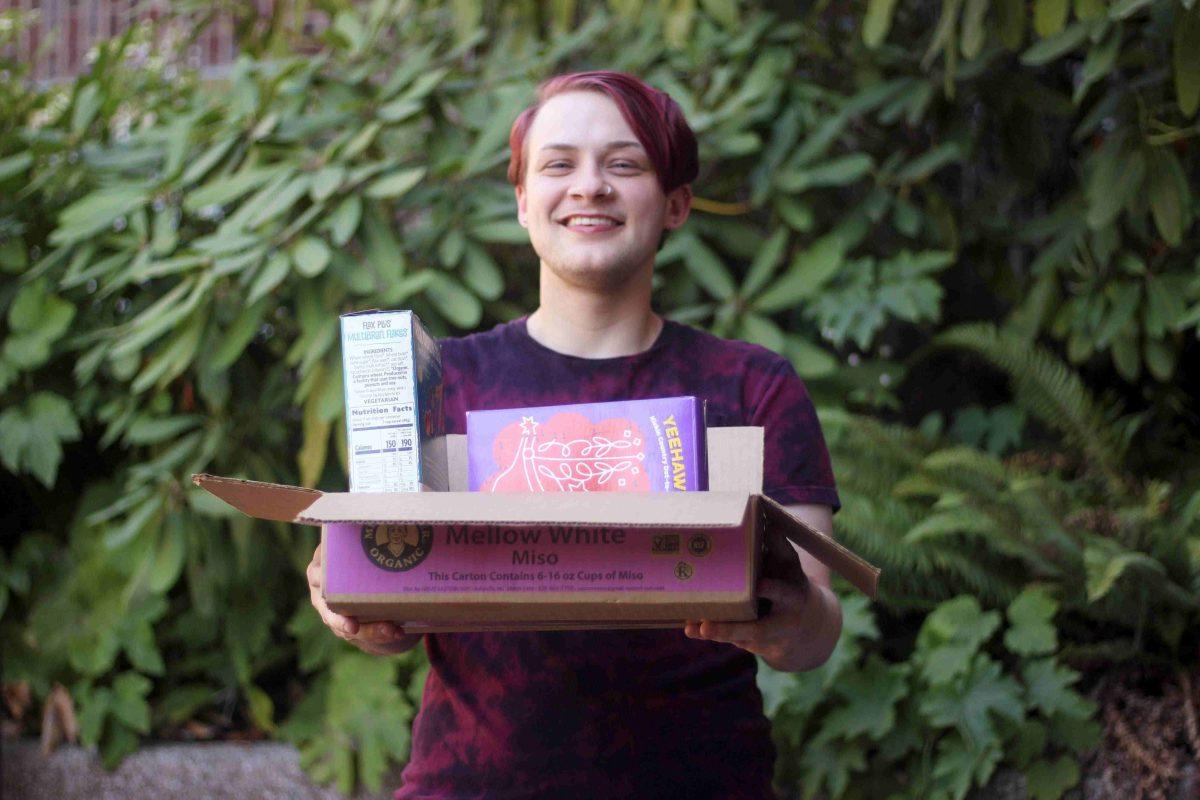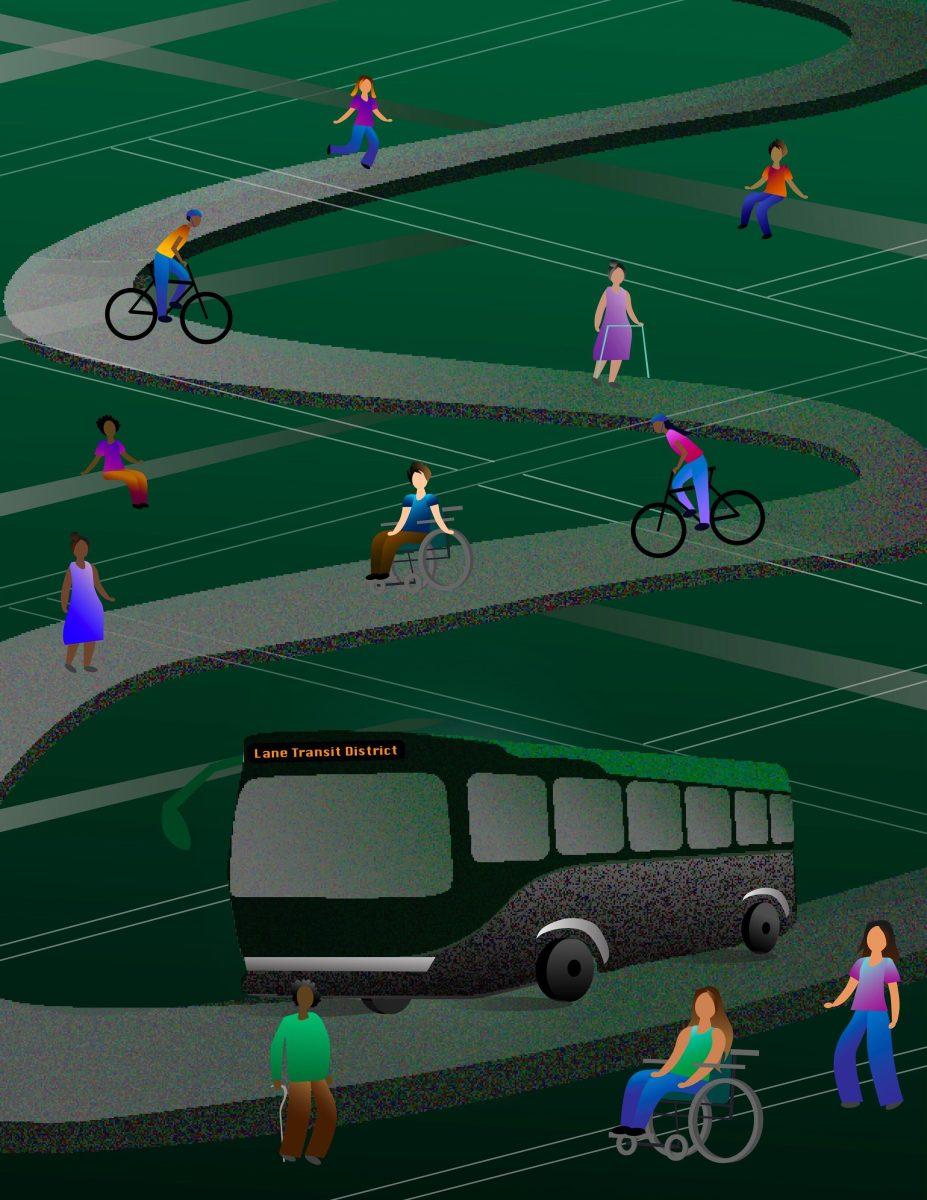A van pulled into the parking lot of Sonrise Christian Church in Northeast Eugene and came to a stop in front of the building’s front entrance. The driver stepped out of the van and opened the loading doors. It was a hot July afternoon, and it was imperative that the perishable items in the van get unloaded quickly.
Jim Coughlin propped open the church doors and went to work hauling the crates from the van into the building. Other volunteers joined in, and in about 10 minutes the van was empty, and the driver hopped back in and took off to pick up the next haul.
The crates were filled with fruits and vegetables, meats and cheeses and cartons of milk, loaves of bread and plastic salad bowls. All of these foods were nearing their expiration dates, but most were still safe to eat.
Inside the church, Leanne Coughlin, another volunteer, sorted the produce by type, picking out and throwing away fruits and vegetables that were “too far gone.” The end result: a walk-in grocery stocked with leafy greens, ripe fruit, cartons of eggs and much more.
The Coughlins are volunteers at Waste to Taste, a food recycling program that collects soon-to-be-thrown-away produce from grocery stores, farms and restaurants. The produce, all of which is checked thoroughly by volunteers to ensure it’s still safe to eat, is stored in refrigerators and pantry spaces at Sonrise. Anyone can sign up to come to the church and pick out whatever they’d like from the pantry.
Waste to Taste’s mission addresses two key food-related issues in Lane County: reducing the amount of food waste that ends up in the landfill, and easing the effects of food insecurity for members of the community.
Nearly 46,000 tons, or 31% of Lane County’s total solid landfill waste, is made up of food waste, according to reporting done by the Register Guard this year. Jesselyn Perkins, project coordinator for the Waste to Taste program, says that Waste to Taste receives tens of thousands of pounds of recycled food.
“We may be rescuing food and making a substantial difference in the lives of the families we’re helping,” Perkins says. “But it’s just a drop in the bucket.”
The other half of Waste to Taste’s mission is addressing food insecurity, which is just as serious of a problem. A study conducted by OSU’s Oregon Policy Analysis Lab found that one in 10 Oregonians experienced food insecurity in 2021. Food insecurity is defined by the Department of Agriculture as “a household-level economic and social condition of limited or uncertain access to adequate food.”
The Supplemental Nutrition Assistance Program (SNAP) kept about 119,000 Oregonians from falling below the poverty line between 2009 and 2012. But state-run food assistance programs like SNAP can only provide so much assistance to food insecure Oregonians. In a survey of SNAP benefits receivers conducted by FOOD for Lane County in 2018, 78% of respondents said their food stamps lasted for about three weeks or less, though SNAP benefits are distributed once a month.
When food stamps run out, the best place to turn for food assistance are food pantries. For many people, the food offered by food pantries acts as a buffer between SNAP benefit refills, and can be the difference between getting a healthy nutritious meal every day and going hungry, Perkins says.
It takes a team of volunteers to ensure that each food pantry is doing what it needs to serve its community. Volunteers stock shelves, help shoppers fill out paperwork, and make pick-ups from food distribution centers.
Of the handful of volunteers at Waste to Taste, Jim and Leanne Coughlin have their own motivations for helping at the pantry.
The couple moved to Eugene three years ago after Jim retired from his faculty position at Indiana University. When the Coughlins still lived in Bloomington, Indiana, Leanne founded a collective of volunteer craft artists called the Persisterhood Workshop. The proceeds the workshop earns through selling the volunteers’ crafts are donated to a rotating list of local nonprofits.
Leanne decided she wanted to take a backseat on the collective, so when the Coughlins moved to Eugene Leanne gave up some of the leadership role. Now, with more open schedules, the couple put their energy towards other volunteer pursuits. The couple pulled weeds for Friends of Hendricks Park, volunteered at a vaccine clinic during the pandemic and now stock and sort produce for Waste to Taste.
Having moved to Oregon fairly recently, the Coughlins agreed that volunteering is a way for the Coughlins to get out of the house and meet people who share their interest in helping the community.
Leanne says volunteering has become so ingrained in her life that it wasn’t a question that she and Jim needed to find a way to help the community when they moved to Eugene.
“Once you’re there for a while and they know they can count on you, you start to feel part of this community. And doesn’t everyone need community?” Leanne says.
That same day at Sonrise Christian Church, as the van pulled away, Charlie Early arrived for his shift. Another volunteer at Waste to Taste, Early was tasked with filling grocery boxes for individuals and families who can’t make it to the food pantry themselves.
Early got to work. He grabbed a box and started filling it with an assortment of ingredients. Fresh produce can be a rare find at most food pantries, Perkins says, so most of the food items prioritized for these boxes are fruits and vegetables.
Early graduated from the University of Oregon last spring with a history degree. He says he has been enjoying having time away from school and that this summer has given him an opportunity to recover from the stresses of university.
Early originally started volunteering with Waste to Taste with a friend, but over time he started coming by himself. He had never volunteered at a food pantry before, but he found himself drawn to the low-pressure environment. Working with other volunteers, he says, is a rewarding experience, and knowing the work they’re doing is helping to reduce food waste and food insecurity is equally gratifying.
Waste to Taste is the first food pantry Early has volunteered with, but he also volunteers at the information desk at the Eugene Public Library. The Eugene Public Library, located directly across the street from Eugene Station, is often used as a hub for services and information by non-locals, and because of that, Early’s able to connect library guests with food pantries, shelters and health resources in Eugene.
“One time I was helping someone who had just gotten off the bus, had never been to Eugene before,” Early says. “He said he was really hungry, so I pulled up a directory of food pantries in Eugene where he could get something to eat. The fact that we could immediately connect him with those services was really cool.”
Lane County’s food insecurity was 13.6% of its total population in 2019; about 50,000 people struggled with hunger that year according to FOOD for Lane County.
As his shift came to a close, Early grabbed one more box to fill with produce. This box he’d take to the community fridge on 18th and Alder, a habit he has taken up since he started volunteering at Waste to Taste. With how much produce would otherwise be thrown away, Early says he saw the community fridge as an opportunity to prolong the life of some good fruits and vegetables.
“Pretty much every time I bring food to the community fridge I see there are people taking from it,” Early says.
Refilling the community fridge is gratifying for Early, he says, because it directly positively affects the people in his community. He’s brought fresh food to the fridge and had someone take the food directly from his hands. That feeling of directly impacting people affected by hunger is what keeps Early coming back to volunteer at Waste to Taste time and time again.
Eugene and Springfield are served by a variety of pantries and free food services. People living outside of Eugene, however, may find it more challenging to make the trip into the city to pick up food.
Pantries in rural Oregon perform the same tasks as those pantries in the city, offering food to folks who are experiencing food insecurity. However, in rural localities, one food pantry may serve multiple cities, and may be the only pantry service within walking distance for miles.
In Harrisburg, Oregon, about eight families left God’s Storehouse, a food pantry and thrift store, with groceries during the afternoon on August 2. As the day got hotter, the number of people showing up to pick up groceries grew, too.
Kris Tapp has volunteered at God’s Storehouse for five years and has spent the last year working the front desk. At the front desk, Tapp is usually the first person a customer encounters when they enter the pantry.
One of Tapp’s main goals in working at God’s Storehouse is to make guests feel welcome and deserving of food. Tapp says there’s a stigma associated with receiving food from a food pantry, that a lot of people who come through the pantry believe that “receiving handouts” is something they ought to be ashamed of. That mindset, Tapp says, is the first thing she tries to change.
“Occasionally, someone will walk in with their head hung down,” Tapp says. “I say, ‘Don’t be like that; so many people come through here who are in the same boat.’”
Located in Harrisburg, Oregon, a town with a population of less than 4,000, God’s Storehouse is frequented by both in-town regulars and new faces from out of town. Tapp says just that day, she helped people from Brownsville, Halsey and Junction City, and it isn’t uncommon for her to see shoppers come from Eugene or Springfield.
Tapp says she takes pride in her ability to encourage God’s Storehouse customers to feel more comfortable taking what they need.
“When they’re new, I like to take them back and introduce them to the other volunteers,” Tapp says. “It makes them feel so much more at home if they get to know us. Then they don’t feel so bad.”
Tapp has been working and living in Harrisburg for 47 years and has a deep background in food service. She started working at her father’s restaurant when she was 11 years old and packed meat at Harrisburg’s Farmer’s Helper for several years. She did a variety of odd jobs before landing a position as a hydraulics specialist at a coach bus manufacturer.
Nearly 40 years ago, Tapp sustained a head and neck injury on the job when a roll of hydraulic hose dropped on her head. After that, she received disability payments until she retired.
Tapp and most of the volunteers at God’s Storehouse are retired and live on social security benefits. These benefits are just enough where social security dependent seniors can expect a low SNAP benefit, Tapp says.
Tapp says she gets $20 from SNAP benefit food stamps. “That amount,” she says, “Feels like a kick in the face.”
From an early age, Tapp says she internalized a negative view of receiving food assistance. She says she was raised to value hard work, and accepting food stamps or food from a pantry was not something that would’ve been alright in her father’s household.
It wasn’t until Tapp was raising her children, and she noticed that some of the kids on her son’s baseball team were going home hungry, that she realized the importance of making sure everybody got something to eat, no matter where the food came from.
Tapp says that the number one way she’s been able to turn that mindset around in her customers is by cultivating a welcoming environment where people don’t feel judged for meeting their basic needs.
Tapp says, “Starting at that desk is where I get them to blossom.”
Waste to Taste volunteer Charlie Early poses with a box of dry goods much like the ones that the organization sorts. He says that the “accessibility of this food pantry is something that I think is the greatest net benefit.”








![[Photo Courtesy of the Lara Family]
Ruben embraces his beloved childhood goat, Katrina.](https://ethos.dailyemerald.com/wp-content/uploads/2025/05/katrina-1-1060x1200.jpg)


